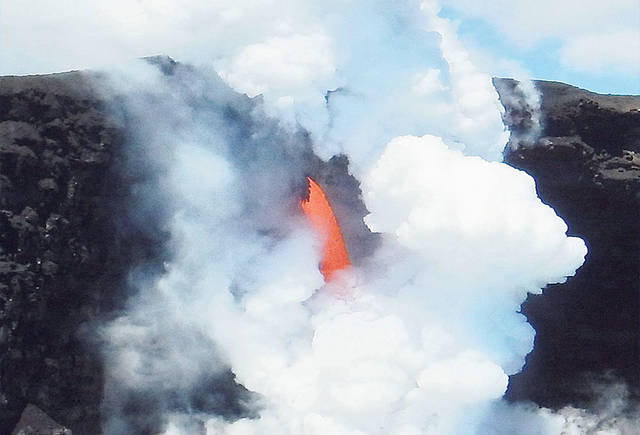Published in the Ocean Watch column, Honolulu Star-Advertiser © Susan Scott
March 25, 2017
Last week on a Hawaii island boat tour, I watched Kilauea Volcano shoot its lava off a cliff. Liquid orange rock spurted like a fire hose from a tube 3 to 6 feet wide, plunging 60-some feet to the ocean in explosions of steam, glass particles and hydrochloric acid.
The ocean absorbed this assault with little fuss, cooling the 2,000-degree Fahrenheit lava in great green steamy swirls.
I felt like the protein in a cauldron of primordial soup.
 A boat tour near Kilauea Volcano started the columnist thinking about the
A boat tour near Kilauea Volcano started the columnist thinking about the
origins of living organisms, especially the theory that life on Earth
began in the ocean, where primitive proteins evolved into cells.
©2017 Susan Scott
The expression “primordial soup” was coined in 1924 when two scientists theorized that 3.7 billion years ago life on Earth began in the ocean. Chemicals there, the theory went, combined to become primitive proteins that evolved into cells.
Scientists today work with vastly more information, from genetic to cosmic, and that has led to other hypotheses about how life began on our planet. One theory maintains that life started in the ocean, but at the bottom of the bowl, in deep sea vents such as those of Kilauea’s backyard cousin, Loihi.
This active volcano lies about 20 miles off the southeast shore of Hawaii island where it rumbles and erupts 3,200 feet underwater.
Submerged volcanoes create cracks that allow seawater to percolate deep into Earth’s crust. As it descends, the water gets hot enough to absorb minerals from the rocks it passes.
When the mineral-laden water gets hot enough, it floats, rising through seafloor passageways into near-freezing water. The drastic change in temperature causes the minerals to fall out, thus forming chimneys called deep sea, or hydrothermal, vents.
The stacks, standing a few feet to a few stories tall, can be piles of gemstones, containing gold, pyrite (fool’s gold), silver and bornite, an iridescent mineral nicknamed peacock ore.
Crabs, giant clams, tubeworms, fish and more live in and near the chimneys. While life as we know it at the surface depends on sunlight and nutrients to survive, these bottom dwellers have neither. They live on Earth’s heat.
Because the chemicals of living organisms can all be made from simpler chemicals that have nothing to do with life, the theory goes that nooks in deep sea vents concentrated organic molecules and minerals, creating chemical reactions that spawned life.
Given that the hot vents host entire communities of marine animals, many still unknown, the theory makes sense. But if that hypothesis doesn’t sit right with you, there are others, ranging from RNA strands to asteroids.
My friend and I had a safe, friendly experience with a local family business, Moku Nui Lava Boat Tour. You can hike to a lava-viewing place, but I recommend seeing the spectacle by boat, too. If anything can get a person pondering life’s big question, it’s floating in a bowl of primordial soup.